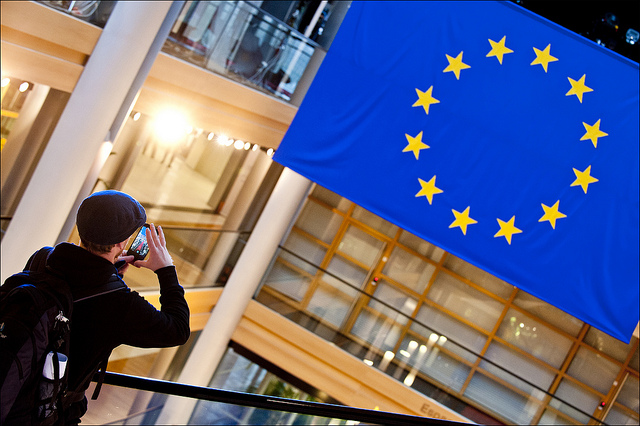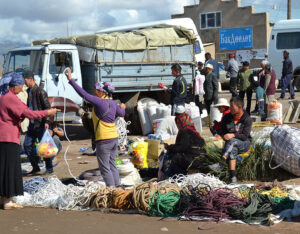Reviewing the EU’s approach to Central Asia

Introduction(1)
The European Union’s (EU) Strategy for Central Asia is being reviewed for the fourth time. Over the last eight years, the EU has been successful in creating several institutionalised mechanisms for working and bolstering relations with Central Asian governments, including an increased presence on the ground. But the overall picture of the EU’s engagement in Central Asia is one of limited to no impact. The region has become more unstable; democracy is seen by the regimes as a threat to their survival; and human rights have been backsliding.
Whereas some global and regional actors have laid out a broader policy vision for Central Asia – ‘New Silk Road’ by the United States (US), ‘Silk Road Economic Belt’ by China – the EU devised a detailed written strategy in 2007 outlining seven priorities ranging from democracy promotion to education and from security to energy and trade interests. The EU’s Central Asia Strategy is more than a policy expression in which just a few objectives are outlined, but less than an extensive and detailed strategy that would ideally be accompanied by an action plan and measureable benchmarks. As the latter will not come about and the EU is unlikely to step back to a simpler document or statement, the strategy is probably here to stay as a reference document for EU policies. This brief looks at the main ingredients of the strategy that need revision and strengthening.
A strategy of engagement
The EU Central Asia Strategy seems ambitious, given that member state activities suggest only a marginal interest in the region, an area that is not a geopolitical priority for Europe. The EU will need to carefully balance limited interests and resources with a few achievable long-term objectives. In 2012, the EU’s review of its Central Asia strategy was heavily focused on the impact of Afghanistan on Central Asia. Today, the bearing of the situation in Afghanistan is less central to Brussels- based policy-makers than the impact of the Ukraine crisis and EU-Russia relations on Central Asia. Whereas these all imply important developments that need to be assessed, the EU should focus on long- term priorities – rather than solely focusing on contemporary issues.
Russian influence on its neighbours will remain substantial. Although the priority of relations for Russia and the EU currently lie in Eastern Europe and to a lesser extent in the South Caucasus, even Central Asia will be affected by increased geo- political competition between Moscow and Brussels. Moscow will try to derail initiatives that bind the EU too closely to Central Asian partners while seeking to bring those republics further within its orbit. The EU should seek partnership with and reform in Central Asian countries, all of which are keen on an alternative to Russia’s policies (and China’s economic influence).
Abolishing the position of an EU Special Representative (EUSR) for Central Asia last March was a mistake (regardless of the budgetary and institutional considerations underlying the decision). EUSRs have been the face of Europe in Central Asia and have had a positive impact on the otherwise limited visibility of the EU in the region. Senior EU officials expect that the new EU foreign policy chief, Federica Mogherini, will soon appoint a high-level European representative to the region who can speak with authority on behalf of the EU institutions and member states.
After the last review in 2012, the EU sought to institutionalise a ‘High-Level Security Dialogue’, but the first meeting in Brussels in June 2013 fell far short of that stated ambition. Some Central Asian governments sent only ambassador-level officials. A second gathering planned for May 2014 in Tajikistan was cancelled owing to a lack of Central Asian interest. The main reason for the EU embarking on this initiative was to address Central Asian security challenges while offering the opportunity to the partners to outline their concerns over Afghanistan’s future. The EU will have another go at this mechanism in the first quarter of 2015 in Tajikistan. The European External Action Service (EEAS) – which is responsible for continuing this process – should consider involving member states at a high level, preferably foreign ministers, to attract Central Asian attention.
One subject that should be considered for the agenda is the fact that many Muslims from Central Asia and Europe have left for Syria to fight for the Islamic State (IS) and their return will prove a security risk. Whereas Europe and Central Asia have very different domestic settings, the motivations of people from both regions fighting for IS are largely similar. Another area that the EU and Central Asian partners could focus on is conflict prevention mechanisms, as conflict in and between Central Asian states cannot be excluded in the future (a series of border incidents between Kyrgyzstan and Tajikistan took place last year while tensions over hydroelectric power between Tajikistan and Uzbekistan remain worrisome).
Although the EU has little influence in Central Asia, adherence to democratic principles should be the centrepiece of engagement, since these countries will only become more reliable partners when they would develop and respect the rule of law and apply democratic governance. For the EU, democracy should be a sine qua non. Central Asian regimes see democracy as a threat to their existence and are more comfortable with Russia’s model of authoritarian governance. The EU should use a smart combination of aid, conditionality and political engagement in seeking out some change in Kyrgyzstan and Tajikistan. The enhanced Partnership and Cooperation Agreement (PCA) with Kazakhstan and the latter’s wish to play a leading international role should also be exploited to encourage Astana to adopt democratic reform. In the more closed dictatorships of Turkmenistan and Uzbekistan the EU lacks leverage, but Brussels has little to lose in discussing democratic reform with them.
Human rights should remain a major focus for the EU in Central Asia. The ‘Human Rights Dialogues’ created by the EU have a modest but very welcome added value mainly as a complimentary tool of ‘persuasion’ (in addition to the UN mechanisms) and with respect to improving the situation of specific (prosecuted) human rights activists. Meanwhile, the ‘Civil Society Seminars’ have the potential to establish a ‘healthy’ dialogue between civil society actors, the government and European actors in Kazakhstan, Kyrgyzstan, and Tajikistan. So far, however, they have mainly resulted in a modest contribution on anti-torture legislation in Kyrgyzstan and Tajikistan. In Turkmenistan and Uzbekistan, there is barely any independent civil society with which to collaborate.
The EU (preferably through an EUSR) should regularly exchange information and discuss development cooperation in Central Asia with other powers, such as the US, China, Turkey, Japan and perhaps Russia at a later stage – depending on that country’s political trajectory. On the ground in Kyrgyzstan and Tajikistan coordination is especially important where donor coordination is concerned; the trick here will be to involve China in such coordination.
Beijing has pledged $40 billion to a fund for a Silk Road Economic Belt (foremost aimed at linking China via Central Asia to Europe) and a Maritime Silk Road (directed at China’s littoral neighbours to the south). These donations will partly benefit Central Asia – primarily aimed at infrastructure development – and dwarf EU assistance (€1 billion over the coming 7 years) or any Russian engagement. EU-Chinese cooperation on Central Asian development, for instance by combining European know- how and Chinese funding, would seem logical. Still, prospects for this to happen seem bleak, since, for example, European firms will find it difficult to buy into Chinese commercial operations in Central Asia.
The options for concrete cooperation in infrastructure and energy projects (outside regional and UN organisations) will remain limited, not only between China and the EU, but even between the US and the EU. For the EU and China, the modus operandi is too different to find a match. In the case of EU-US cooperation both actors do not regard Central Asia as a priority (like the Middle East), which limits the will for concrete cooperation.
Bilateral approaches
The EU’s main focus in Central Asia should be on bilateral relations, rather than regional approaches (which as a regional Union based on integration, the EU tends to adopt). The Central Asian states have become more diversified and expect to build their own bilateral relations with Europe. Engagement and assistance to each country will need to be further tailored to ensure that cooperation is in the best interest of both parties. This should also include an increased effort by the EU to engage with Central Asia’s marginalised civil society organisations through funding, projects, networks, debates, consultations and so on.
Kazakhstan is the top priority for most EU member states in Central Asia. Half of foreign investment in Kazakhstan is of European origin and about 40 per cent of Kazakh exports go to Europe. Last year the EU and Kazakhstan concluded negotiations on an ‘enhanced’ PCA, embodying Astana’s special relations with Brussels. This year the enhanced PCA should be signed, although attention is warranted owing to the country’s lack of democratic reform and poor human rights record. Kazakhstan’s fear of being locked into the Russian-led Eurasian Economic Union (EEU) gives the EU some leverage, which could be taken up by the European Parliament or member states to persuade Kazakhstan to make some concrete reform steps.
If tensions between the EU and Russia arise in Central Asia, Kyrgyzstan is the most likely ‘battleground’. Its upcoming membership of the EEU places the country more firmly in Russia’s orbit. The relatively open character of the country is under threat and the democratically elected government is not performing well. Whereas in EU eyes Kyrgyzstan was foremost an opportunity for democratisation, the immediate future seems more geared towards Kyrgyz geopolitical choices between powerful neighbours and Western actors. The EU (and other democracy supporters) will be severely challenged in obtaining results from Bishkek. Ethnic tensions still lingering after the 2010 violence between the Kyrgyz and Uzbek populations in the south of the country remain a matter that needs monitoring.
Tajikistan also plans to join the EEU but is unstable and vulnerable to outside influences from Russia and China (and to a lesser extent Iran). For the EU, getting development assistance right – by being tough on the conditions for giving aid, including checks on implementation – will be essential as corruption is rife (and impeding economic development) and EU border management assistance programmes are hampered by the country’s elites that are involved in the lucrative opiates trade.
Turkmenistan is the only republic in Central Asia where the EU does not yet have a full-fledged Delegation. The reason for this seems to be budgetary, which is strange as energy remains officially a priority for the EU in Central Asia, and Turkmenistan is the only new opportunity for gas imports (opportunities in Kazakhstan’s oil industry are already being exploited by Europe): this might be explained by the fact that gas imports from Turkmenistan are not expected any time soon. Currently Turkmenistan exports most of its gas to China, in the absence of any progress in building a Trans Caspian pipeline to Azerbaijan and from there a connection across the Caucasus and Turkey to the EU. As only a few EU member states are represented in Ashgabat, it would make sense for the EU to have a Delegation in order to engage and monitor developments in this geo-politically challenged country, bordering Afghanistan and Iran as well as the Caspian Sea.
EU relations with Uzbekistan have not really taken off since the lifting of all sanctions (2009) and the establishment of a Delegation in Tashkent (2011). The regime is difficult to deal with, while European trade and other interests are very limited. This non-aligned and most populous Central Asian country is, however, crucial for regional stability. It is of interest to the EU to keep channels of communication open and to assess local developments. New EU development funding is currently fully geared towards rural development; a questionable venture though in a sector that does need support.
Regional approaches
EU regional cooperation initiatives will need to be carefully focused and if applied, should be made more flexible. As regional lines become ever more blurred and the current five ‘Stans’ are not eager to be rounded up by the EU in joint formats, the focus should be on cooperation with two, three or more countries that are willing and able to work on a particular subject. This could also involve other countries in the broader region such as Afghanistan, Azerbaijan or Mongolia.
The EU’s three regional programmes – rule of law, water and environment, and education – for Central Asia should be evaluated in-depth. If useful, they should be expanded, if not, they should be scrapped.
The rule of law (rather than democracy and human rights) is an odd subject to take up in a regional format with Central Asian governments, but is at least possible to address, as democracy as such is not open for joint discussion. The initiative’s platform has created a useful database of European rule of law projects in Central Asia. It is doubtful, however, whether the broader initiative (run by France and Germany) will actually coordinate, foster and track meaningful reform.
The same can be said about the water and environment initiative led by Italy and Romania. This is a subject important to all Central Asian republics. However, sensitivities and tensions between several countries make it difficult to make progress. Moreover, most international donor programmes increasingly seek a national rather than a regional approach which has greater practical impact.
Over the last eight years, no member state has been willing to take on the education initiative. This is disappointing, as it is this sector that deserves most attention – though not necessarily on a regional basis. If the EU wants to contribute to the development of Central Asia, become more visible, act strategically over the long-term, and counter Russian influence, it should invest heavily in higher education (and where funds allow, also in technical vocational and secondary education). However, such an investment (largely consisting of Central Asian students having the opportunity to study in Europe) will only be useful if programmes are able to tackle or circumvent the risk of brain- drain and unequal access (of the elites) to higher education.
The BOMCA border management programme is the EU’s flagship security programme in Central Asia. The ninth phase of BOMCA over the coming three years has only been allocated €5 million. The reason for this is that the programme’s implementation is being transferred from the United Nations Development Programme (UNDP) to a group of EU member states (Latvia, Lithuania, Hungary and Portugal). The parallel programme CADAP (EU Central Asia Drug Action Programme) was already earlier transferred from UNDP to GIZ, the German development agency. This is a positive development as the EU’s Central Asia policy will need more member state involvement. There is now also an opportunity to think through EU border management support. The EU will need to decide if the programme will focus on border areas between the five Central Asian republics (some republics barely participate) or on the ‘external’ Tajikistan-Afghanistan border where many other donors are also active (while being affected by Tajikistan’s unwillingness to undergo wholesale reform of border security). Central Asian recipients have always sought equipment support from donors while the EU preferred border guard training. Next steps could involve a stronger focus on migration issues and border monitoring.
Development assistance
From 2007 to 2013 the EU’s development assistance to Central Asia amounted to roughly €750 million – of which one- third was allocated to regional programmes and two-thirds to bilateral initiatives. From 2014 to 2020, the EU plans to spend about €1 billion in Central Asia. The EU has learned from the first seven year-cycle of Development Cooperation Instrument (DCI) spending (paralleling the political strategy), in which it spread its modest funds over a long list of priorities and areas. In the new cycle, the main recipients Kyrgyzstan (rule of law, education and rural development) and Tajikistan (health, education and rural development) will have only three sectors, and Uzbekistan (rural development) and Turkmenistan only one (education). Kazakhstan does not receive bilateral aid anymore as it is considered an upper middle-income country, while in Turkmenistan aid will likely be phased out in 2017 when the country is also likely to reach the upper middle-income status.
It is not exactly clear what the rationale is behind the increase of pledged allocations to Central Asia over the current cycle (even though it makes sense that fewer countries should receive funds for a smaller number of concrete initiatives). The region is not a priority for the EU and earlier development aid has been heavily affected by recipients’ unwillingness to engage in democratic reform and tackle endemic corruption. Meanwhile the practice of sectoral budget support in Kyrgyzstan and Tajikistan is continued, even though this is avoided by most other international donors. The EU, however, continues the practice – with increased funding – which has advantages but also grave risks. Over the coming years, monitoring of its implementation will be essential for the EU’s development approach to Kyrgyzstan and Tajikistan. Central Asia watchers also wonder about the steep rise in allocations to Uzbekistan (€168 million from 2014 to 2020) that had received little funding under the former funding cycle, and is mentioned by the few active donors as extremely difficult to work with. Still, the EU has more than doubled the budget for Uzbekistan without making clear why the chances of real impact are suddenly higher. A hands-on approach and close monitoring are warranted to ensure that support to Uzbekistan’s rural sector has the desired effect.
Conclusion
The EU is unlikely to radically revise its strategy for Central Asia as the document is still a useful catalogue of relations with the region, and member states are unlikely to push for an overhaul of policy as their interests there are not essential, and as concerns closer to home in Eastern Europe take precedence. If the EU would decide to narrow its focus on a few matters where it would seek concrete impact, the focus should be on: bilateral partnerships and increased ties with civil societies; support for democratisation and strengthening the defence of human rights; modest security cooperation based on conflict prevention; and a more simplified and effective development policy with a heavy emphasis on education.
- This policy brief is based on an earlier EUCAM memo (January 2015) for European policy-makers. The author thanks Vera Axyonova, Marlene Laruelle, Andreas Marazis, Sebastien Peyrouse, and Tika Tsertsvadze for their input.



![shutterstock_1240181551 [Omgezet]](https://eucentralasia.eu/wp-content/uploads/2024/10/shutterstock_1240181551-Omgezet-300x248.jpg)



